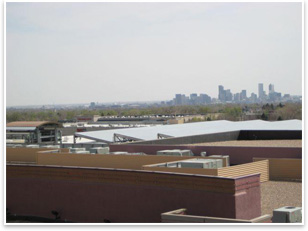
Photovoltaics and Wind Turbines Infuse Colorado Development by Heather Livingston
Belmar has promoted responsible use of limited natural resources and the reduction of energy use from the outset of the project. Embracing the tenets of mixed-use development, Belmar was designed to reduce personal automobile reliance and promote pedestrian traffic and mass transit by crisscrossing the development with multiple regional bus routes. In addition, prior to starting site work, the developer saved approximately 130 mature trees from the original site, transplanted them to a temporary nursery, and later replanted them in the development. Approximately halfway through construction currently, at full build out Belmar will eventually contain approximately 3 million square feet of developed space, says Matt Stokes, a development director with Continuum. Included in the Belmar development at present are roughly 550 residences, 70 stores, and 14 restaurants. They also have an arts district with galleries, studios, and The Lab, a civic institution dedicated to contemporary art and thought. The Lab offers art exhibitions by leading regional, national, and international contemporary artists, weekly lectures, and creative adult education programs.
The company also drew on the U.S. Green Building Council’s LEED® criteria to guide the design and development of many buildings in the project. A three-story mixed-use building has received LEED Silver certification, as have the buildings that house a natural foods grocery, beverage store, and two adjacent mixed-use buildings and retail spaces. Belmar’s housing also was built to meet high levels of efficiency and sustainability. The McStain townhomes are Energy Star® rated, and the Harvard Courtyard Homes conform to the Environments for Living® program requirements.
Two other clean energy strategies in use at Belmar are solar-powered pay-and-display parking kiosks that manage 350 on-street parking spaces and an on-site urban wind farm. “There are 14 wind turbines [each about a foot in diameter] that we placed on top of the light poles in one of our service parking lots,” explains Stokes. “They throw out enough power to feed most, if not all, of the costs to light that parking lot.” Stokes says that aside from the very important ecological benefit, Belmar receives two key advantages from the alternative energy sources. “It’s going to do two things,” he says. “One is that it’s going to stabilize our energy expenses because we’ve locked in on a rate with Xcel. Two is that over time, as energy prices increase, the rate that we’ve locked in will keep our costs stable.” Stokes anticipates that the array will be fully operational this fall.
|
||
Copyright 2008 The American Institute of Architects. All rights reserved. Home Page |
||
home
news headlines
practice
business
design
recent related
› COTE Marks Earth Day with Top Ten Green Building Awards
› San Francisco Moves Toward Far-Reaching Green Building Code
› Chicago Housing Complex Wins Green Design Award
For more information on the Belmar development, visit their Web site.
To learn about the Xcel Energy Solar Rewards Program, log onto their Web site.
Images courtesy of Belmar.



